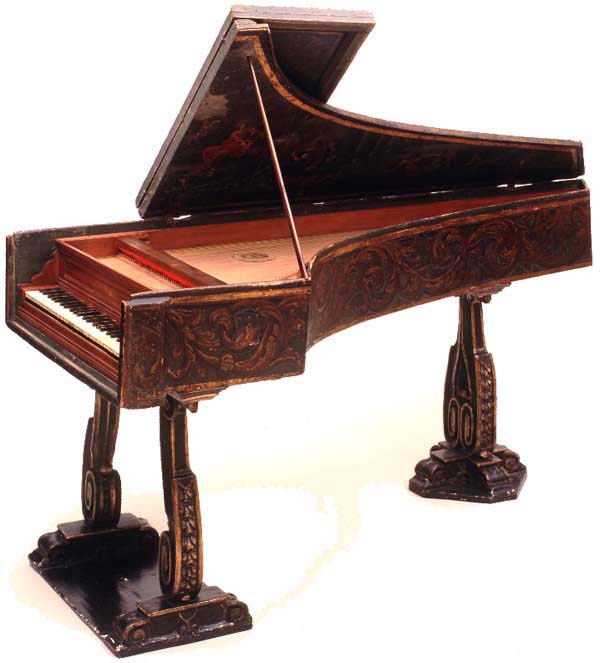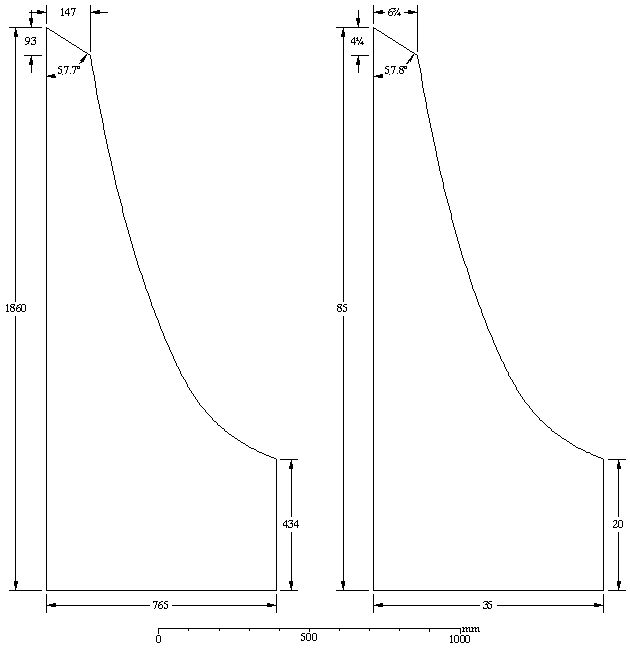The determination of the location of the centre of
construction of the anonymous Italian harpsichord, c.1620,
Russell
Collection of Early Keyboard Instruments, Edinburgh, Cat. No. HS1-A1620.2

Anonymous Italian Harpsichord, Naples,
c.1620
Russell Collection of Early Keyboard
Instruments, Edinburgh, Cat. No. HS1-A1620.2
The city
or region of construction of an anonymous instrument can be determined by
analysing the size of the unit of measurement used in its construction. Until the time of the Napoleonic invasions
of the Italian peninsula each of the major cities in Italy used its own unit of
measurement and the size of these units varied from place to place. The braccio,
piede, canna, palmo, etc. and
their subdivision into the oncia, soldo or pollice were therefore characteristic of each of the centres in
which instruments and virtually all other manufactured items were built. Therefore if the unit of measurement used in
the design and construction of an instrument can be determined, this can be
used in turn to establish the centre its origin.
It is quite clear that any maker of instruments - or any other object for that matter - would have worked on a day-to-day basis using convenient numbers and fractions of his local unit of measurement. For the simple reason that whole numbers or simple fractions are easy to remember, an artisan would work in simple numbers of his unit of measurement when designing and executing the object he is making, especially when most of the measurements used are, to a certain extent at least, arbitrary. Until recently the inch, a twelfth part of a foot, was still being used in much of the English-speaking world. Most of the measurements used by hand-workers, artisans, artists, architects, designers and all of those involved in industry and commerce were based on simple numbers of inches, feet and yards, or on their simple subdivision. Using their local unit of measurement, this was equally true of Italian workers in the historical period engaged in each of these different fields of activity.
Only where it is really necessary and where dictated by some rule or theoretical concept would an instrument builder use a complicated or irrational division of the local unit of measurement. This has been shown clearly from the ground-breaking study made of many types of musical instruments by Herbert Heyde[1]. Heyde’s work shows that makers applied their local unit of measurement to many different aspects of the design of their instruments. For stringed keyboard instruments this ranged all the way from the design of the case to the string scalings to the division of the keyfronts and keytails of the keyboard. But what Heyde, and more recently Hubert Henkel[2], have failed to note is that the makers of stringed keyboard instruments at least designed their instruments beginning with the baseboard. Once they had designed and cut out the baseboard, they then worked literally from there upwards. However, the instrument case measurements used by Heyde and Henkel to suggest theories of numerology in instrument building have been taken (incorrectly in my view) for Italian instruments from the outside case dimensions including the case-side thicknesses, although not including the added measurements of the upper or lower mouldings. For instruments built in the Italian tradition where the case sides are applied to the outside edges of the baseboard, the measurements of Heyde and Henkel take no account of the dimensions of the baseboard before the planks making up the case-side were added.
The work that I have done recently in this field (see the section on Geometry and the Unit of Measurement) shows that the maker began his design by drawing out the baseboard using dimensions which were simple integers or fractions of the local unit of measurement, and the case sides that he then applied to the sides of the baseboard in the workshop were cut to a height also equal to a simple number of units (or units plus simple fractions). The combination of the fact that the case sides were hand thicknessed and therefore not all of exactly the same thickness (not even from one end of the board to the other) and the irregular geometry of both polygonal virginals and harpsichords, meant that the final outside dimensions of the instrument were totally unrelated to the local unit of measurement used by the maker. Therefore a maker starting with two identically-dimensioned baseboards constructed according to his design could end up with slightly differently-sized cases after the sides were added to the two identical baseboards. Similarly it is the height of the case without the top cap moulding that the maker would measure in his local unit of measurement[3]. He would mark out a number of planks all of the same width in convenient units and then cut and apply these to the outside edges of the baseboard. Experience measuring Italian instruments has shown that even here, the case-wall heights are often slightly less than expected in places where the top of the case has been planed down to equalise the level of the top of the case at the corners when these did not match exactly after the case sides were assembled. It is therefore the maximum case-wall height that corresponds to the makers design and not the average case-wall height.
The measurements of the baseboard without the case sides and of the case height without the top cap moulding are given in Table 1 below:
Measurement Local Length
of
in
mm unit oncia in mm
Component
of tail perpendicular to spine: 147 = 6¾ once gives 21.78
Component of tail parallel to spine: 93 = 4¼ once gives
21.88
Long side: 1860 = 85 once gives 21.88
Baseboard width:
765 = 35 once gives 21.86
Baseboard cheek (short side): 434 = 20 once gives 21.709
Maximum case sides height: 196 = 9 once gives
21.77
Total:
3495 = 160 once
Average: 21.844mm/oncia
These measurements are shown on the diagram below in Figure 1 where the actual measurements in mm are shown on the left, and the measurements in units of the local measurement are shown on the right. A look at a number of reference works on metrology giving the units of measurement used in the various centres in Italy during the historical period shows that in Naples, before 1841, the palmo, divided into 12 units, had a length of 262.01mm[4]. Hence the oncia had a length of:
![]()
Other sources also give the length of the canna with 8 palmi and 96 once in Naples as 2109.36mm[5] so that
![]()
These two are clearly two different ways of expressing
the same size of the unit of measurement in this region, and this is clearly
the unit that was used in the construction of this instrument. No other centre had a unit of measurement as
close in value to that found for this instrument. The error between the value found here and the value given in the
tables of metrology is only 0.05%!
This therefore suggests that Naples is
the centre in which this harpsichord was built.
These
measurements are shown on the diagram shown in Figure 1 below where the actual
measurements in mm and the measured tail angle are shown on the left, and the
nominal measurements in units of the Neapolitan oncia are shown on the right.

Baseboard measurements without the case
sides
Anonymous Italian Harpsichord, Naples,
c.1620
Russell Collection of Early Keyboard
Instruments, Edinburgh, Cat. No. HS1-A1620.2
![]()
Footnotes:
[1] See: Herbert Heyde, Musikinstrumentenbau, 15.-19. Jarhundert. Kunst Handwerk Entwurf, (VEB Deutscher Verlag für Musik, Leipzig, 1986).
[2] See: Hubert Henkel, Besaitete Tasteninstrumente. Fachbuchreihe das Musikinstrument, Vol. 57 (Verlag Erwin Bochinsky, Frankfurt-am-Main, 1994).
[3] In the North-European tradition where the case sides are much thicker than in Italian practice, the moulding is often cut into the top of the case side itself, and the case sides are usually (but not always) applied to the top of the baseboard. It is therefore the case height less the thickness of the baseboard that the maker would measure out in a simple number of local units.
[4] See: Horace Doursther, Dictionnaire universel des poids et mesures anciens et modernes, (M Hayer, Brussels, 1840), and Giovanni Croci , Dizionario universale dei pesi e delle misure in uso presso gli antichi e moderni con ragguaglio ai pesi e misure del sistema metrico, (The Author, Milan, 1860).
[5] See: Hercule Cavalli, Tableaux comparatifs des mesures, poids et monnaies modernes et anciens…, (Paul Dupont, Paris, 2/1874), Horace Doursther, Dictionnaire universel des poids et mesures anciens et modernes, (Brussels, 1840), Barnaba Oriani, Istruzione su le misure e su i pesi che si usano nella Repubblica Cisalpina, (Milano, 1891), and Luigi Pancaldi, Raccolta ridotta a dizionario di varie misure antiche e moderne coi loro rapporti alle misure metriche…, (Sassi, Bologna, 1847),
Grant
O’Brien
May,
2001